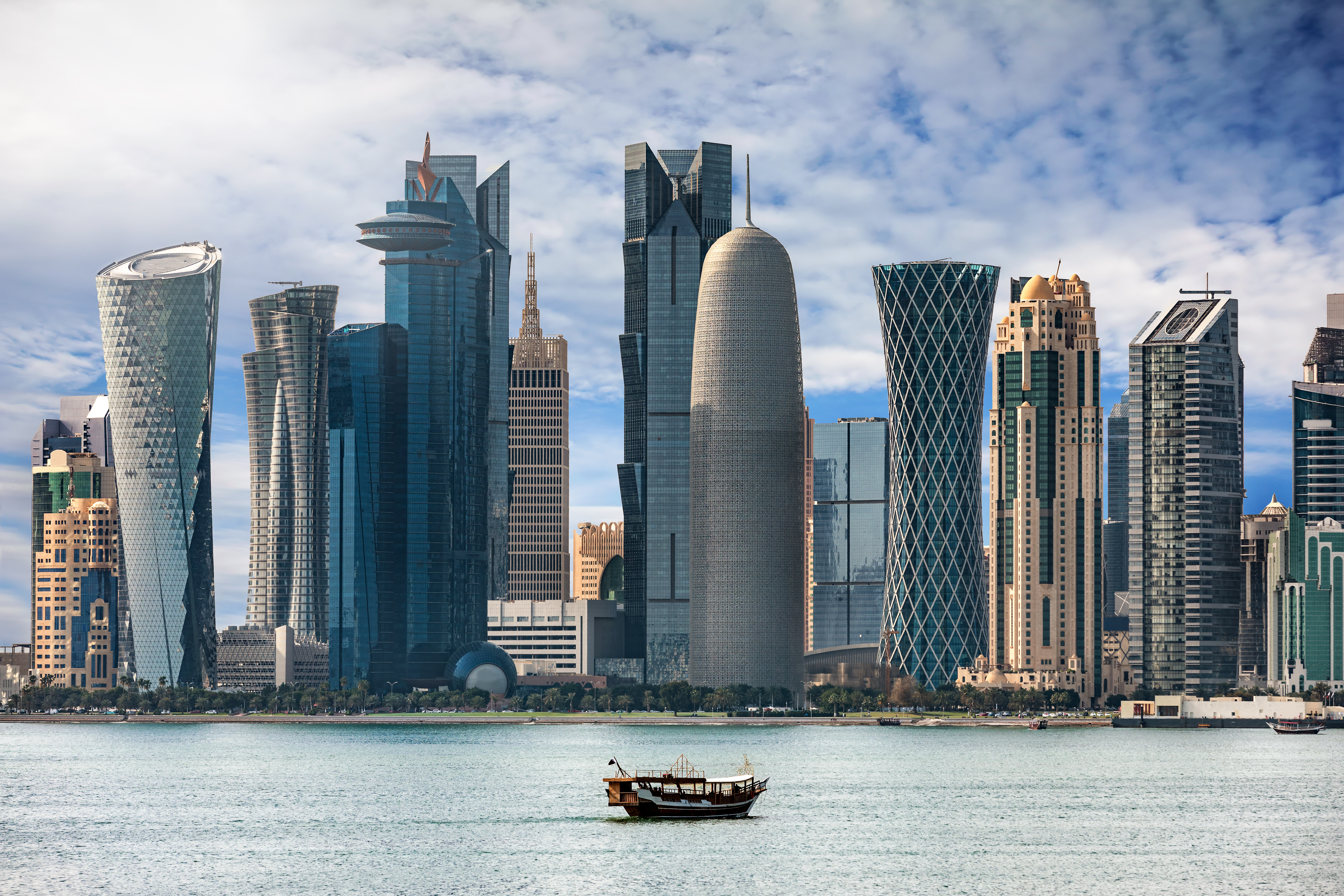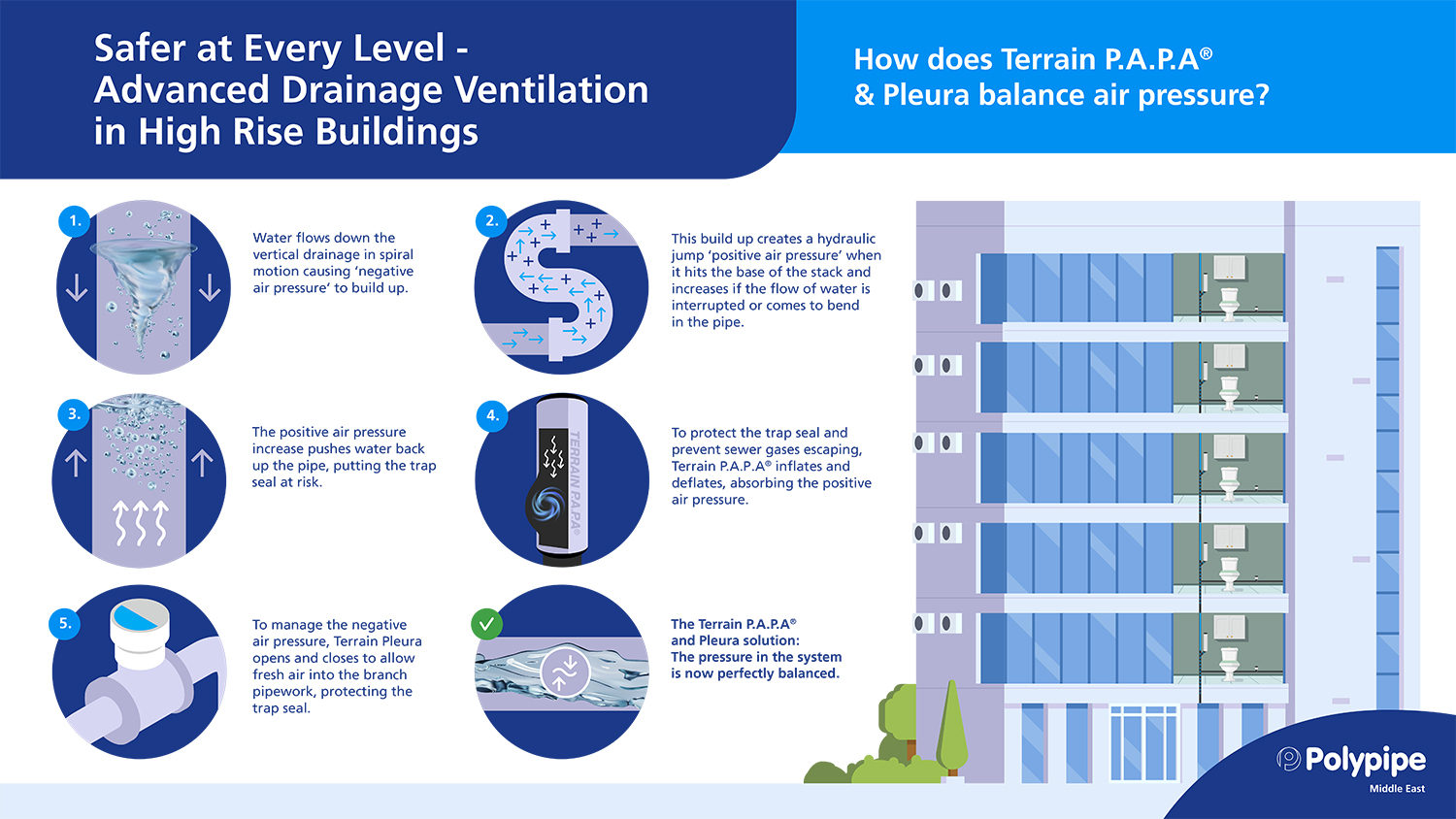Breathe Easy: A Fresh Drainage Solution For High-Rise Developments
Monday 18th March 2024

Across the GCC, architectural ambition and urban demand are transforming the modern cityscape. In recent years, its cities have evolved into thriving metropolises, attracting tourists and expats from all over the globe. As economic opportunity and population size have shot up, so have the buildings that house them. These cities have seen a surge in awe-inspiring high-rise buildings that garner international attention.
Today the UAE has the third highest number of skyscrapers in the world, after only China and the USA. It is also home to 32 super-tall skyscrapers, including the world's tallest — the Burj Khalifa. In fact, in 2020, more high-rise buildings were developed in Dubai than in any other city on Earth – and this number is only continuing to grow.
This appetite for sky-high buildings extends to other GCC nations. The easing of some building restrictions in KSA means that its city skylines are now undergoing rapid transformation – upon completion, the Jeddah Tower will be the first building in the world to surpass one kilometre in height. Meanwhile, other high-rise buildings in the region – such as Qatar’s Katara Towers and Kuwait’s Al Hamra Tower – are also recognised as both awe-inspiring and aesthetically stunning feats of modern engineering.
Evidently, across the GCC, a new type of ‘space race’ dedicated to vertical living is well underway.
However, the complex architecture of high-rise buildings poses its own set of drainage challenges. A highly specialised and innovative approach must be considered to create high-rise buildings that operate effectively and protect human health.
Drainage challenges faced by high-rise buildings
From horizontal space limitations to design challenges, higher buildings often require more complex components to operate effectively, which can lead to spiralling costs. However, budget balancing cannot come at the expense of product durability or occupant safety.
Indoor Air Quality (IAQ) is considered a key determinant of human health, which makes it essential for the well-being of occupants within any building. But in high-rise buildings, where thousands of occupants can live and work alongside each other simultaneously yet may be unable to open windows when required, good quality air ventilation becomes even more important. In fact, the reduction of ambient odours was an integral part of the UAE's General Environmental Policy 2021, and the nation has taken great strides in recent years to introduce policies which improve indoor air quality due to wider health, economic and environmental implications.
This is also where ventilation solutions such as those of Nuaire, another company within the Genuit Group, have a significant part to play in ensuring the IAQ of high-rise buildings. For example, its innovative range of active ventilation systems works to continuously extract stale air from specific areas, and allow the inflow of fresh, clean air. Many of its products also incorporate advanced air filtration systems which have been designed to trap particles of varying sizes, from dust to volatile organic compounds (VOCs), which can be found in a range of everyday items. These ventilation systems work to ensure safer, more comfortable indoor environments with advanced IAQ throughout buildings of all sizes and scales.
When looking to optimise the IAQ of a building, we often consider factors such as excess moisture, tobacco residue and even pollutants such as VOCs from building materials and furnishings. However, another crucial consideration is a building’s water management and drainage systems – and the higher the building, the greater the challenge.
In high rises, water has much further to flow through a drainage system. And, as water descends, a suction-like negative pressure is created which draws it further down. If this flow is interrupted, or if it approaches a change of direction, the negative pressure can change into a positive pressure which can lead to the water travelling back up the pipe. This can risk the integrity of a pipe’s trap seal, which could lead to odorous sewer gases seeping into buildings.
Unpleasant odours within a high-rise building can not only affect the emotional well-being of occupants – it can also become unhygienic, ultimately contributing to poor IAQ. This, in turn, can lead to health risks for occupants such as respiratory health issues. An ‘unhealthy’ building means high tenant turnover rates, which can affect rental income and even cause reputational damage for a building developer or contractor.
How can Polypipe Middle East help?
Polypipe Middle East’s Terrain portfolio has been developed to provide end-to-end, fit-for-purpose drainage solutions that can be adapted to any regulation or project requirement. This range includes two products that work in harmony to balance air pressure and optimise IAQ for even the most ambitious of high-rise developments: Terrain P.A.P.A.® (Positive Air Pressure Attenuator) and Pleura Vent System.
Designed specifically with multi-storey developments in mind, these systems provide a smart solution to air pressure and drainage ventilation and ensure optimal air quality.
So, what does each system do? And how do they work together? Whilst the Terrain P.A.P.A.® is a positive pressure reduction device, the Pleura Vent system is an air pressure regulator which acts as an Air Admittance Valve (AAV). When used in conjunction with each other, these systems mitigate the effects of positive and negative air fluctuations within a single-stack drainage system, allowing fresh air into the branch pipework. By controlling the air movement within the drainage system, they help to protect the water trap seals within the building. This significantly reduces the risk of sewer gas seepage.
Why Terrain P.A.P.A.® and Pleura Vent System?
Terrain P.A.P.A.® and Pleura Vent System provide several advantages for high-rise contractors and developers, particularly for ambitious projects. Firstly, they enable flexibility in design. Because the composition of the plumbing system can scale with – and adapt to – different architectural designs, it is the ideal water management and drainage ventilation solution for a more diverse range of use cases. For example, the Terrain Pleura Vent System was recently chosen for Dubai’s Museum of the Future.
Secondly, Terrain P.A.P.A.® and Pleura Vent System address the issue of space efficiency in high-rise developments. Horizontal space is saved by allowing multiple plumbing fixtures on different floors to connect from a single main vertical pipe, without the need for secondary vent pipes and with no compromise on performance. This enables developers and contractors to maximise usable square footage whilst also enhancing the efficiency of the process.
Thirdly, despite the higher upfront cost, investing in a Terrain P.A.P.A.® and Pleura Vent System initially proves to be a wise choice due to its long-lasting durability. By minimising the need for extensive piping and fixtures, it reduces the risk of potential failures, leading to lower material and maintenance expenses in the long run. As well as providing contractors and developers with better value for their investment, the reduced risk of failure also enhances occupant comfort over time.
As buildings grow taller and high-rise living becomes the new normal throughout the GCC, the implementation of effective water management and drainage solutions is essential to ensure a safe and healthy urban development. The key lies in the design and installation of systems that are fit for purpose – no matter the size or scale of a skyscraper.
To learn more about how Polypipe Middle East’s systems and solutions can safeguard the air quality within your next high-rise project, contact us today.
Tel: +971 (0) 4 518 3000
Email: middleeast@polypipe.com

